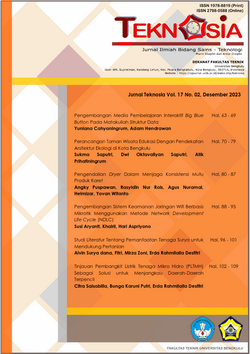Main Article Content
Abstract
This research aims to process rubber latex into SIR 20 at PT. Bukit Angkasa Makmur and the performance of the dryer machine in controlling the quality of SIR 20 rubber. The data collection method for this practical work is carried out based on the source. The data can be divided into two, namely primary data and secondary data. From the results of this research it was found that analyzing the quality of SIR 20 rubber products on dryer machine performance in controlling temperature, material weight and rubber density on the trolley on the dryer machine must be given great attention and really maintained so that product quality does not experience a decline in quality (rubber product defects). Rubber product defects occur due to many human/human factors, machine factors, temperature factors, material factors, environmental factors. The dryer process is a process of drying crumb rubber by removing water content with the aim of preserving it, making it easier to transport, and preparing for the next process. This process really determines the final quality of the rubber because without drying it cannot be produced because the quality does not meet the standard specification requirements. The heat used in the dryer machine comes from the biomass burning process, namely using palm shells as the main fuel in the combustion machine, heat from the machine. The combustion flows through an iron pipe to the dryer machine as heat in the crumb rubber drying process. A dryer machine is a machine used to make rubber dry and cook the rubber crumbs so that they can be processed further. This research was carried out from December 2022 to January 2023, at PT. Bukit Angkasa Makmur. For a series of experiments carried out on the problem of overcoming rubber quality problems, because the mixing of raw material quality and rubber cleanliness greatly influences the rise and fall of rubber quality.
Article Details
Copyright (c) 2023 Angky Puspawan, Rasyidin Nur Rois, Agus Nuramal, Helmizar, Yovan Witanto

This work is licensed under a Creative Commons Attribution-ShareAlike 4.0 International License.
Authors who publish with this journal agree with the following terms:
- Authors retain copyright and grant the journal the right of first publication with the work simultaneously licensed under a Creative Commons Attribution License that allows others to share the work with an acknowledgement of the work's authorship and initial publication in this journal.
- Authors are able to enter into separate, additional contractual arrangements for the non-exclusive distribution of the journal's published version of the work (e.g., post it to an institutional repository or publish it in a book), with an acknowledgement of its initial publication in this journal.
- Authors are permitted and encouraged to post their work online (e.g., in institutional repositories or on their website) prior to and during the submission process, as it can lead to productive exchanges, as well as earlier and greater citation of published work (See The Effect of Open Access).
- This work is licensed under a Creative Commons Attribution-ShareAlike 4.0 International License.
References
-
[1] Manual Book, Pabrik Karet Crumb Rubber, PT Bukit Angkasa Makmur.Jl.Bengkulu Curup Km.14 Kembang Seri, Kecamatan Talang
Empat Kabupaten Bengkulu Tengah Provinsi Bengkulu.
[2] Maspanger, D. R., Agus,. L.A, dan Sinurat, M. (1999). Potensi briket dan batubara mentah sebagai bahan bakar alternatif untuk
pengeringan karet. Warta Perkaretan, 18 (1-3), 2-3.
[3] Vachlepi. A. 2007. Laporan kegiatan masa percobaan. Balai Penelitian Sembawa-Pusat Penelitian Karet. 19-21.
[4] Ompusunggu, M. (1987). Pengolahan Lateks Pekat. Medan : Balai Penelitian Perkebunan Sungai Putih.
[5] C. F. Zuhra, “Karet,” Univ. Sumatra Utara, Medan, pp. 1–30, 2006.
[6] Setyamidjaya, 1993, Karet : Budidaya dan Pengolahan, Penerbit Kanisius, Yogyakarta.
[7] Goutara ,Miko.1985.Evaluasi Efektifitas Mesin dengan penerapan Total Productive maintenance (studi kasus : PT Hadi Baru). Tugas
Akhir Jurusan Teknik Industri.Universitas Sumatera Utara.
[8] Dewi.S,dan Syamsuri D.2019.manajemen perwatan industry.Jakarta: Penerbit Graha Ilmu.
[9] Spivaksvsky and Dyachkop. Conveyor and realited Equipment Peace Publisher.
References
Empat Kabupaten Bengkulu Tengah Provinsi Bengkulu.
[2] Maspanger, D. R., Agus,. L.A, dan Sinurat, M. (1999). Potensi briket dan batubara mentah sebagai bahan bakar alternatif untuk
pengeringan karet. Warta Perkaretan, 18 (1-3), 2-3.
[3] Vachlepi. A. 2007. Laporan kegiatan masa percobaan. Balai Penelitian Sembawa-Pusat Penelitian Karet. 19-21.
[4] Ompusunggu, M. (1987). Pengolahan Lateks Pekat. Medan : Balai Penelitian Perkebunan Sungai Putih.
[5] C. F. Zuhra, “Karet,” Univ. Sumatra Utara, Medan, pp. 1–30, 2006.
[6] Setyamidjaya, 1993, Karet : Budidaya dan Pengolahan, Penerbit Kanisius, Yogyakarta.
[7] Goutara ,Miko.1985.Evaluasi Efektifitas Mesin dengan penerapan Total Productive maintenance (studi kasus : PT Hadi Baru). Tugas
Akhir Jurusan Teknik Industri.Universitas Sumatera Utara.
[8] Dewi.S,dan Syamsuri D.2019.manajemen perwatan industry.Jakarta: Penerbit Graha Ilmu.
[9] Spivaksvsky and Dyachkop. Conveyor and realited Equipment Peace Publisher.
